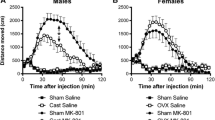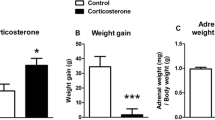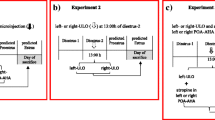Abstract
In previous studies we have found that blockade of NMDA (N-Methyl-d-Aspartic-Acid)-type glutamatergic receptor with intracerebroventricular (ICV) selective drugs induces an inhibition of lordosis in ovariectomized (OVX) estrogen primed rats receiving progesterone or luteinizing hormone releasing hormone (LHRH). By the opposite way, stimulation with NMDA in OVX estrogen primed rats induced a significant increase of lordosis. In the present study the action of an α1-noradrenergic antagonist, HEAT (BE 2254/2-beta-4-Hydroxyphenyl-Ethyl-Aminomethyl-1-Tetralone), and Metoprolol, a β-noradrenergic antagonist, were studied injecting them ICV previously to NMDA administration in treated OVX estrogen primed rats. In experiment 1, the enhancing effect on lordosis induced by NMDA at high dose (1 μg) was abolished by HEAT administration (P < 0.001 for 3 and 6 μg), and the LH plasma levels were decreased only with the higher dose (P < 0.05), suggesting that behavioral effects are quite more sensitive to the α-blockade than hormonal effects. In experiment 2, enhancing effects on lordosis behavior were not observed with neither the NMDA at low dose (0.5 μg) nor the metoprolol alone (5.71 μg), but a synergism was observed when both were simultaneously administered (P < 0.001). The LH plasma levels were increased by Metoprolol alone (P < 0.05), and powered by the combination with NMDA at low dose (P < 0.01 vs. SAL and NMDA alone); no differences were observed with Metoprolol. LH increase was observed with Metoprolol even without behavioural modifications. These findings strongly suggest that facilitatory and inhibitory effects of NMDA in this model are mediated by α- and β-adrenergic transmission in both, behavioral and hormonal effects.




Similar content being viewed by others

References
Ahlenius S (1993) Brain monoaminergic neurotransmission in the mediation of lordosis behavior in the female rat. Neurosci Biobehav Rev 17:43–49
Anselmo-Franci JA, Franci CR, Krulich L, Antunes-Rodrigues J, McCann SM (1997) Locus Coeruleus lesions decrease norepinephrine input into the medial preoptic area and medial basal hypothalamus and block the LH, FSH and prolactin preovulatory surge. Brain Res 767:289–296
Bakker J, Baum MJ (2000) Neuroendocrine regulation of GnRH release in induced ovulators. Front Neuroendocrinol 21(3):220–262
Bourguignon J-P, Gerard A, Mathieu J, Simons J, Franchimont P (1989) Pulsatile release of gonadotropin-releasing hormone from hypothalamic explants is restrained by blockade of N-methyl-D-aspartate receptors. Endocrinology 125:1090–1096
Brann DW, Mahesh VB (1994) Excitatory amino acids: function and significance in reproduction and neuroendocrine regulation. Front Neuroendocrinol 15:3–49
Cicero TJ, Meyer ER, Bell RD (1988) Characterization and possible opioid modulation of N-methyl-D-aspartic acid induced increases in serum luteinizing hormone levels in the developing male rat. Life Sci 42:1725–1732
Curran-Rauhut MA, Petersen SL (2003) Oestradiol-dependent and -independent modulation of tyrosine hydroxylase mRNA levels in subpopulations of A1 and A2 neurones with oestrogen receptor (ER)alpha and ER beta gene expression. J Neuroendocrinol 15:296–303
Donoso AO, López FJ, Negro-Vilar A (1990) Glutamate receptors of the non-N-methyl-D-aspartic acid type mediate the increase in luteinizing hormone-releasing hormone release by excitatory amino acids. Endocrinology 126:414–420
Donoso AO, Seltzer AM, Navarro CE, Cabrera RJ, López FJ, Negro-Vilar A (1994) Regulation of luteinizing hormone-releasing hormone and luteinizing hormone secretion by hypothalamic amino acids. Braz J Med Biol Res 27(4):921–932
Etgen AM (2003) Ovarian steroid and growth factor regulation of female reproductive function involves modification of hypothalamic alpha 1-adrenoceptor signalling. Ann N Y Acad Sci 1007:153–161
Etgen AM, Karkanias GB (1990) Estradiol regulates the number of α1 but not β or α2 noradrenergic receptors in hypothalamus of female rats. Neurochem Int 16:1–9
Etgen AM, Ungar S, Petitti N (1992) Estradiol and progesterone modulation of norepinephrine neurotransmission: Implications for the regulation of female reproductive behavior. J Neuroendocrinol 4:255–271
Gargiulo PA, Donoso AO (1995) Interaction between glutamate and luteinizing hormone releasing hormone (LHRH) in lordosis behavior and luteinizing hormone release (LH): further studies on NMDA receptor mediation. Physiol Behav 58:169–173
Gargiulo PA, Muñoz V, Donoso AO (1992) Inhibition by N-Methyl-D-aspartic acid (NMDA) receptor antagonist of lordosis behavior induced by estrogen followed by progesterone or luteinizing hormone releasing hormone (LHRH) in the rat. Physiol Behav 52:737–739
Gorzalka BB, Mendelson SD, Watson NV (1990) Serotonin receptor subtypes and sexual behavior. In: Witaker-Azmitia PM, Peroutka SJ (eds) The neuropharmacology of serotonin, vol 600. New York Academy of Sciences, New York, pp 435–446
Johnson MD, Crowley WR (1986) Role of central serotonin systems in the stimulatory effects of ovarian hormones and naloxone on luteinizing hormone release in female rats. Endocrinology 118:1180–1186
Kawahara H, Kawahara Y, Westerink BH (2001) The noradrenaline-dopamine interaction in the rat medial prefrontal cortex studied by multi-probe microdialysis. Eur J Pharmacol 418:177–186
Kaynard AH, Pau KY, Hess DL, Spies HG (1990) Gonadotropin-releasing hormone and norepinephrine release from the rabbit mediobasal and anterior hypothalamus during the mating-induced luteinizing hormone surge. Endocrinology 127:1176–1185
Kow LM, Harlan RE, Shivers BD, Pfaff DW (1985) Inhibition of the lordosis reflex in rats by intrahypothalamic infusion of neural excitatory agents: evidence that the hypothalamus contains separate inhibitory and facilitatory elements. Brain Res 341:26–34
Landa AI, Cabrera RJ, Gargiulo PA (2006) Prazosin blocks the glutmatergic effects of N-methyl-D-aspartic acid on lordosis behavior and luteinizing hormone secretion in the estrogen-primed female rat. Braz J Med Biol Res 39:365–370
Lee WW, Berghorn KA, Smith MS, Hoffman GE (1997) Alpha 1-adrenergic receptor blockade blocks LH secretion but not LHRH cFos activation. Brain Res 747:236–245
López FJ, Donoso AO, Negro-Vilar A (1990) Endogenous excitatory amino acid neurotransmission regulates the estradiol-induced LH surge in ovariectomized rats. Endocrinology 126:1771–1773
Martins-Afferri MP, Ferreira-Silva IA, Franci CR, Anselmo-Franci JA (2003) LHRH release depends on locus coeruleus noradrenergic inputs to the medial preoptic area and median eminence. Brain Res Bull 61:521–527
McCarthy MM, Curran GH, Feder HH (1991) Excitatory aminoacid modulation of lordosis in the rat. Neurosci Lett 126:94–97
Mendelson SD (1992) A review and reevaluation of the role of serotonin in the modulation of lordosis behavior in the female rat. Neurosci Biobehav Rev 16:309–350
Navarro CE, Cabrera RJ, Donoso AO (1994) Release of 3H-noradrenaline by excitatory aminoacids from rat mediobasal hypothalamus and the influence of aging. Brain Res Bull 33(6):677–682
Navarro CE, Cabrera RJ, Donoso AO (1995) Interaction between glutamate and GABA on 3H-noradrenaline release from rat hypothalamus. Brain Res Bull 37(2):119–122
Samson WK, McCann SM, Chud L, Dudley CA, Moss RL (1980) Intra- and extrahypothalamic luteinizing hormone releasing hormone (LHRH) distribution in the rat with special reference to mesencephalic sites which contain both LHRH and single neurons responsive to LHRH. Neuroendocrinology 31:66–72
Schainker BA, Cicero TJ (1980) Acute central stimulation of luteinizing hormone releasing hormone by parenterally administered N-methyl-D, L-aspartic acid in the male rat. Brain Res 184:425–437
Williams M, Totaro JA, Clineschimidt BV (1978) Interaction of 2-[beta-(4-hydroxyphenyl) ethylaminomethyl] tertralone (BE-2254: ‘HEAT’) with catecholamine receptors in rat brain membranes. J Pharm Pharmacol 30:390–391
Yang SP, Voogt JL (2001) Mating-activated brainstem catecholaminergic neurons in the female rat. Brain Res 894:159–166
Acknowledgments
We thank E. Morsucci, D.M. Videla, A. Funes, A. Morón, L. Peñafort, and J. González for their technical support, and Dr. Graciela Jahn for the LH Assay. We thank to Dr. Roberto Yunes for their comments on the present paper. We thank Dr. Juan Delius for his constant support and counseling. Pascual Angel Gargiulo, Ricardo Jorge Cabrera, and Claudia Bregonzio are established researchers of the National Council of Research (CONICET) of Argentina. Adriana Inés Landa is Research Coordinator of the Laboratory of Neurosciences and Experimental Psychology. José Vicente Lafuente Sánchez is full Professor of Neuroscience (University of the Basque Country, Spain). Angel José Martín Gargiulo and Mercedes María Lucrecia Gargiulo contributed in a very significant manner in this paper. This study was granted by CONICET (Consejo Nacional de Investigaciones Científicas y Técnicas) (PEI N° 0386/97) and a grant of Volkswagen Foundation (Germany) (Project: “Nucleus Accumbens Septi und kognitives Verhalten”, Delius-Gargiulo) and is part of a cooperation with the Laboratory of General Psychology of the University of Konstanz, Germany. We thank Mrs. Sara Roitman for her invaluable cooperation. We thank Prof. Dr. Juan Delius for his constant support and counseling.
Author information
Authors and Affiliations
Corresponding author
Rights and permissions
About this article
Cite this article
Landa, A.I., Gargiulo, Á.J.M., Gargiulo, M.M.L. et al. Alpha and beta noradrenergic mediation of NMDA glutamatergic effects on lordosis behaviour and plasmatic LH concentrations in the primed female rat. J Neural Transm 116, 551–557 (2009). https://doi.org/10.1007/s00702-009-0217-x
Received:
Accepted:
Published:
Issue Date:
DOI: https://doi.org/10.1007/s00702-009-0217-x



